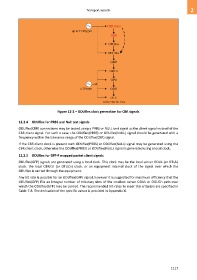Page 1127 - 5G Basics - Core Network Aspects
P. 1127
Transport aspects 2
Figure 12-2 – ODUflex clock generation for CBR signals
12.2.4 ODUflex for PRBS and Null test signals
ODUflex(CBR) connections may be tested using a PRBS or NULL test signal as the client signal instead of the
CBR client signal. For such a case, the ODUflex(PRBS) or ODUflex(NULL) signal should be generated with a
frequency within the tolerance range of the ODUflex(CBR) signal.
If the CBR client clock is present such ODUflex(PRBS) or ODUflex(NULL) signal may be generated using the
CBR client clock, otherwise the ODUflex(PRBS) or ODUflex(NULL) signal is generated using a local clock.
12.2.5 ODUflex for GFP-F mapped packet client signals
ODUflex(GFP) signals are generated using a local clock. This clock may be the local server ODUk (or OTUk)
clock, the local ODUCn (or OTUCn) clock, or an equipment internal clock of the signal over which the
ODUflex is carried through the equipment.
Any bit rate is possible for an ODUflex(GFP) signal, however it is suggested for maximum efficiency that the
ODUflex(GFP) fills an integral number of tributary slots of the smallest server ODUk or ODUCn path over
which the ODUflex(GFP) may be carried. The recommended bit-rates to meet this criterion are specified in
Table 7-8. The derivation of the specific values is provided in Appendix XI.
1117

